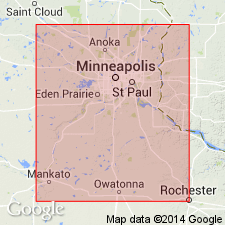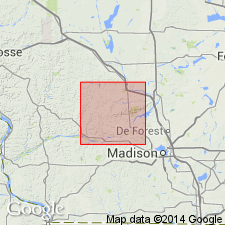
- Usage in publication:
-
- Van Oser member
- Modifications:
-
- Original reference
- Dominant lithology:
-
- Sandstone
- AAPG geologic province:
-
- Sioux uplift
Summary:
Pg. 1902; 1939, GSA Bull., v. 50, no. 8, p. 1238 (table 2), 1240. Van Oser member of Jordan sandstone. Coarse massive gray to white sandstone. Overlies Norwalk member. Forms uppermost division of St. Croixan series in Minnesota. Commonly overlain by Oneota dolomite. Has been referred to as TELLERINA-SAUKIELLA zone in Minnesota classification. Age is Late Cambrian (St. Croixan).
Probably named from exposures on Van Oser Creek, Scott Co., southeastern MN.
Source: US geologic names lexicon (USGS Bull. 1200, p. 4057).

- Usage in publication:
-
- Van Oser Member
- Modifications:
-
- Overview
- AAPG geologic province:
-
- Wisconsin arch
Summary:
Jordan Formation [in WI] is now generally considered to have two major subdivisions: the lower Norwalk and the upper Van Oser Members. The Sunset Point Member is present near the top of the Jordan in Dane Co., but has not been identified in the area of this report (Sauk Co.). The Coon Valley, considered here a member of the overlying Oneota Formation, was assigned to the Jordan by Odom and Ostrom (1978). The two members are distinguished by grain size. The Norwalk contains fine quartz sand, with some very fine and medium sand, and the Van Oser contains medium sand, with some fine and coarse sand. Norwalk also contains considerable feldspar. Members are mapped together is this report and total about 20 m. Scattered throughout the quartzose sandstone are thin beds of greenish-gray shale. The Jordan is, for the most part, nonglauconitic, noncalcareous, and nondolomitic; planar and cross-bedded, locally bioturbated, and so interpreted as marine. Age of the Norwalk Member shown in stratigraphic column as Late Cambrian; age of the Van Oser Member shown as Late Cambrian and Early Ordovician.
Source: GNU records (USGS DDS-6; Reston GNULEX).
For more information, please contact Nancy Stamm, Geologic Names Committee Secretary.
Asterisk (*) indicates published by U.S. Geological Survey authors.
"No current usage" (†) implies that a name has been abandoned or has fallen into disuse. Former usage and, if known, replacement name given in parentheses ( ).
Slash (/) indicates name conflicts with nomenclatural guidelines (CSN, 1933; ACSN, 1961, 1970; NACSN, 1983, 2005, 2021). May be explained within brackets ([ ]).

